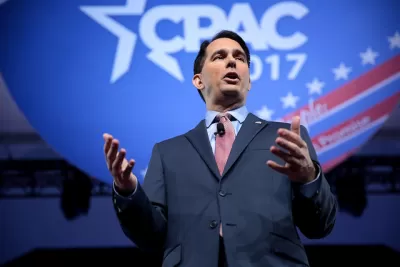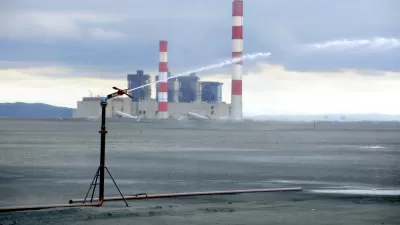Politics and economics win over public health in Racine County as the EPA exempted the area around the Foxconn's massive facility from meeting stricter ozone pollution standards, saving the company from investing in smog-reducing equipment.

The latest tradeoff to be exposed for Foxconn's potential $9 billion investment in a 20 million-square-foot manufacturing plant in Mount Pleasant is air quality, not only from the huge increase in traffic but by having the U.S. Environmental Protection Agency relax standards in ozone pollution.
"By dramatically reducing the size of the areas required to crack down on smog, Trump EPA Administrator Scott Pruitt overruled the agency’s career staff, a move that will save Foxconn from having to make expensive improvements as it builds a sprawling new electronics plant in Racine County, just north of the Illinois border in an area with some of the state’s dirtiest air," reports Michael Hawthorne, who focuses on environment and public health issues for the Chicago Tribune, on May 2.
Tweaking the list of counties in violation of federal smog standards is the latest attempt by Pruitt to roll back or delay environmental regulations enacted during the Obama administration.
If Pruitt had followed the EPA staff report, Foxconn and other industrial sources of smog-forming pollution in Racine County would have been required to install more effective pollution-control equipment, scale back production or broker costly emissions-trading agreements with cleaner facilities.
Political influences
"The issue 'had acquired political overtones both because of Walker’s concerns and because President Trump, who owes his surprise 2016 election victory in part to Wisconsin voters, has touted the Foxconn project,' noted the E&E News, which covers energy and environmental issues," reports Bruce Murphy for Urban Milwaukee on May 3.
Hawthorne adds that "the areas removed from the list were suggested by Republican elected officials who have sought to curb the EPA’s authority to force industries to clean up the air." The move is considered a political victory for Gov. Scott Walker who will make the Foxconn investment a centerpiece of his re-election efforts.
"We continue to search for ways to balance between environmental stewardship and a positive, pro-jobs business environment," said Walker about the move that will negatively affect the public health of southeast Wisconsin residents.
But a union leader saw it otherwise.
“Unfortunately, the people living around Foxconn in Racine and Kenosha counties in Wisconsin are the big losers,” said Michael Mikulka, president of American Federation of Government Employees Local 704. “They will have to breathe in more air pollution every day because of Pruitt’s gift to the governor.”
Nonattainment
As the Wisconsin Department of Natural Resources' (DNR) April 3 presentation on air pollution control permitting [pdf] indicates, the Clean Air Act requires the state to submit plans for areas in nonattainment in any of the six criteria pollutants, ozone being one, to comply with National Ambient Air Quality Standards. Thanks to Pruitt, that becomes much easier for Foxconn and DNR.
Average smog concentrations in all of the Wisconsin areas initially targeted by the EPA exceeded the new federal limit during the past three years, according to state monitoring data.
The 2015 federal limit for ground-level ozone [O3] is 0.070 ppm or 70 ppb. "Smog levels peaked at 83 ppb last year in Racine County and averaged 75 ppb between 2015 and 2017," adds Hawthorne.
Will move withstand litigation?
Many of Pruitt's rollbacks have not stood-up to litigation, the most relevant for this post being on smog levels. On March 12, EPA was ordered by the federal District Court for the District of Northern California to identify regions of the country that are not meeting the 2015 standards for ground-level ozone and publish their findings by April 30. A May 1 news release provides an update.
That lawsuit was filed by California Attorney General Xavier Becerra, joined by 13 other states and the District of Columbia, one of more than a dozen environmental lawsuits, and he's batting a thousand, according to the Los Angeles Times.
Addressing the Racine County smog standard exemption, John Walke, a former EPA attorney who leads the clean air program at the nonprofit Natural Resources Defense Council, told the Chicago Tribune, “This is another ridiculous attempt by Scott Pruitt and the Trump administration to violate the law. We are looking forward to seeing them in court again.”
Neighboring states were also impacted by changes
Pruitt also pared back the list of counties with dirty air in Illinois and Indiana, a decision that could add to Chicago’s chronic problems with pollution linked to asthma attacks, heart disease and early deaths.
Not helping matters is Pruitt's rollback of light-duty vehicle emissions standards, which prompted California and 16 other states and the District of Columbia to sue the Trump administration on May 1.
New air quality research reveals "unexpected slowdown" in gains
Relaxing air quality standards to benefit industry will make it more difficult to improve air quality in the U.S. A new study published in the Proceedings of the National Academy of Sciences finds that progress has been slowing, reports Doyle Rice for USA TODAY on April 30. Two precursors to ozone pollution were studied, carbon monoxide and nitrogen oxide (NOx).
The study said pollution levels from nitrogen oxide fell 7% from 2005 to 2009, but only dropped 1.7% from 2011 to 2015. That translates to a 76% slowdown between the late 2000s and early 2010s.
This contrasts sharply with a more rosy outlook from the Environmental Protection Agency, which said the slowdown in reductions was only 16%.
FULL STORY: EPA chief Pruitt overrules staff, gives Wisconsin's Walker, Foxconn big break on smog

Maui's Vacation Rental Debate Turns Ugly
Verbal attacks, misinformation campaigns and fistfights plague a high-stakes debate to convert thousands of vacation rentals into long-term housing.

Planetizen Federal Action Tracker
A weekly monitor of how Trump’s orders and actions are impacting planners and planning in America.

Chicago’s Ghost Rails
Just beneath the surface of the modern city lie the remnants of its expansive early 20th-century streetcar system.

Bend, Oregon Zoning Reforms Prioritize Small-Scale Housing
The city altered its zoning code to allow multi-family housing and eliminated parking mandates citywide.

Amtrak Cutting Jobs, Funding to High-Speed Rail
The agency plans to cut 10 percent of its workforce and has confirmed it will not fund new high-speed rail projects.

LA Denies Basic Services to Unhoused Residents
The city has repeatedly failed to respond to requests for trash pickup at encampment sites, and eliminated a program that provided mobile showers and toilets.
Urban Design for Planners 1: Software Tools
This six-course series explores essential urban design concepts using open source software and equips planners with the tools they need to participate fully in the urban design process.
Planning for Universal Design
Learn the tools for implementing Universal Design in planning regulations.
planning NEXT
Appalachian Highlands Housing Partners
Mpact (founded as Rail~Volution)
City of Camden Redevelopment Agency
City of Astoria
City of Portland
City of Laramie




























